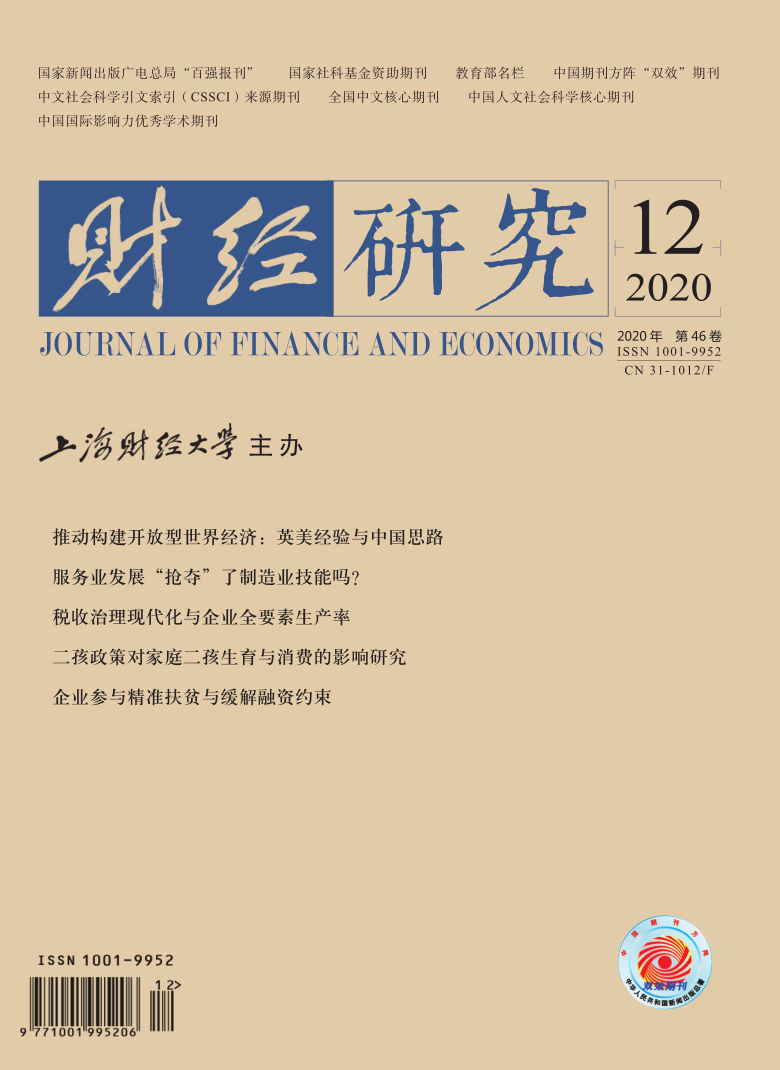[1] Dai Y Y, Pan Y, Feng S. Are Chinese enterprises’ charitable donations “political contributions”? Evidence from the replacements of the municipal party secretaries[J]. Economic Research Journal, 2014, (2): 74-86. (In Chinese)
[2] Du S F, Shi H G, Zhang Y Q. Research on the influencing factors of the precise poverty alleviation behavior of listed companies in China: Based on the perspective of social responsibility[J]. Public Finance Research, 2019, (2): 104-115. (In Chinese)
[3] Du Y, Chen J Y. Political connections, charitable donations and government subsidies: Empirical evidence from money-losing listed companies in China[J]. Journal of Finance and Economics, 2016, (5): 4-14. (In Chinese)
[4] He R, Liu B Y, Wang J J. Bank-firm relationship, institutional environment and MSME credit availability[J]. Journal of Financial Research, 2012, (11): 103-105. (In Chinese)
[5] Huang X B, Zhong H W. Research on the investment and effectiveness of targeted poverty alleviation of listed firms in China: Based on the analysis of targeted poverty alleviation information in 2017[J]. Finance and Accounting, 2019, (9): 21-25. (In Chinese)
[6] Li D, Yuan C, Liao G M. Short-selling mechanism and analysts’ forecast optimism bias: Based on the test of DID model[J]. Accounting Research, 2016, (9): 25-31. (In Chinese)
[7] Li S H, Lu Q R, Song X Z. Corporate donation among China’s money-losing enterprises[J]. China Industrial Economics, 2012, (8): 148-160. (In Chinese)
[8] Li W A, Wang P C, Xu Y K. Philanthropy, political connection and debt finance: Reciprocal behavior of governments and private enterprises[J]. Nankai Business Review, 2015, (1): 4-14. (In Chinese)
[9] Li Y S, Lu Y Q. Can Industrial poverty alleviation policies reduce the livelihood vulnerability of out-of-poor farmers? Policy effect evaluation and mechanism analysis[J]. Public Finance Research, 2020, (5): 63-77. (In Chinese)
[10] Liu X, Chen X C. The CSRC Punishment, analyst following and corporate bank debt financing: Empirical evidence from information disclosure violations[J]. Accounting Research, 2018, (1): 60-67. (In Chinese)
[11] Lu S F, Chen S X. Does governmental favoritism reduce financing constraints of firms: A quasi-natural experiment from China[J]. Management World, 2017, (5): 51-65. (In Chinese)
[12] Luo D L, Zhen L M. Privately control, political relationship and financing constraint: Based on the empirical evidence of listed private firms in China[J]. Journal of Financial Research, 2008, (12): 164-178. (In Chinese)
[13] Pan Y, Ning B, Ji X G, et al. Clan genes in private companies: Evidence from financial constraints[J]. Economic Research Journal, 2019, (7): 94-110. (In Chinese)
[14] Tang Y J, Zuo J J, Li H D. The impact of institutional environment transition on corporate philanthropic behavior[J], Economic Research Journal, 2014, (2): 61-73. (In Chinese)
[15] Wang Y L, Su Y. How to achieve the miracle of China’s poverty alleviation: The precise administrative mode of China’s poverty alleviation and national governance system foundation[J]. Management World, 2020, (4): 195-209. (In Chinese)
[16] Wei Z H, Zeng A M, Li B. Financial ecological environment and corporate financial constraints: Evidence from Chinese listed firms[J]. Accounting Research, 2014, (5): 73-80. (In Chinese)
[17] Xu S, He X Y, Zhong K. The belt and road initiative and Chinese firms’ financial constraints[J]. China Industrial Economics, 2019, (7): 155-173. (In Chinese)
[18] Xue S, Xiao X. Donation: Is it a way to strengthen political connections in private enterprises?[J]. Journal of Finance and Economics, 2011, (11): 102-112. (In Chinese)
[19] Yang Q, Ji Y, Wang Y N. Can high-speed railway improve the accuracy of analysts’ earnings forecasts? Evidence from listed companies[J]. Journal of Financial Research, 2019, (3): 168-188. (In Chinese)
[20] Yao L J, Fu F J, Cheng X K. Tax avoidance, financing ability of debt and cost of debt[J]. China Soft Science, 2018, (10): 117-135. (In Chinese)
[21] Yu M G, Pan H B. The relationship between politics, institutional environments and private enterprises’ access to bank loans[J]. Management World, 2008, (8): 9-21. (In Chinese)
[22] Zhang J L, Liu S Y, Duan C R. A study on Xi Jin-ping’s “Precise Poverty Alleviation” theory[J]. Economist, 2020, (2): 25-32. (In Chinese)
[23] Zhu E W, Wu J, Liu H Y. Bank-firm relationship analysis based on co-occurrence in news texts: Evidence from listed real estate companies in China[J]. Journal of Financial Research, 2019, (2): 117-135. (In Chinese)
[24] Zhu J G. The Theory and evidence of cross-shareholders between banks and firms: International comparison[J]. Studies of International Finance, 2012, (2): 58-68. (In Chinese)
[25] Brammer S, Jackson G, Matten D. Corporate social responsibility and institutional theory: New perspectives on private governance[J]. Socio-economic review, 2012, 10(1): 3-28.
[26] Gao Y. Philanthropic disaster relief giving as a response to institutional pressure: Evidence from China[J]. Journal of Business Research, 2011, 64(12): 1377-1382.
[27] Harrison G W, Rutherford T F, Tarr D G. Trade liberalization, poverty and efficient equity[J]. Journal of development Economics, 2003, 71(1): 97-128.
[28] Kaplan S N, Zingales L. Do investment-cash flow sensitivities provide useful measures of financing constraints?[J]. The Quarterly Journal of Economics, 1997, 112(1): 169-215.
[29] Klein B, Leffler K B. The role of market forces in assuring contractual performance[J]. Journal of Political Economy, 1981, 89(4):615-641.
[30] Kroszner R S, Strahan P E. Bankers on boards: monitoring, conflicts of interest, and lender liability[J]. Journal of Financial Economics, 2001, 62(3): 415-452.
[31] Lys T, Naughton J P, Wang C. Signaling through corporate accountability reporting[J]. Journal of Accounting & Economics, 2015, 60(1): 56-72.
[32] Matten D, Moon J. “Implicit” and “explicit” CSR: A conceptual framework for a comparative understanding of corporate social responsibility[J]. Academy of management Review, 2008, 33(2): 404-424.
[33] Mosley P, Hulme D. Microenterprise finance: Is there a conflict between growth and poverty alleviation?[J]. World development, 1998, 26(5): 783-790.
[34] Shapira R. Corporate philanthropy as signaling and co-optation[J]. Social Science Electronic Publishing, 2012, 80(5): 1889-1939.





 7521
7521  7475
7475

